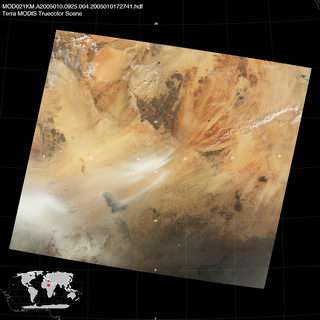Desert dust feeds tropical rainforest

The Amazon rainforest in South America relies on dust transported by winds from the Sahara desert in North Africa to replenish the nutrients and minerals in its soils. For the first time, scientists have proved that over half the dust transported to the Amazon comes from one location in the Sahara, the Bodele depression, even though it makes up less than 1% of the Sahara. Without this supply of dust to replenish the nutrients in its soils, the Amazon could become a wet desert.
The work is reported today in the first edition of the Institute of Physics open-access journal, Environmental Research Letters.
Dr Ilan Koren, lead author of the paper said: “The Bodélé is known as the largest source of dust in the world, but until now no-one had any idea how much dust it emits and what portion arrives in the Amazon. Using satellite data, we have calculated that it provides on average more than 0.7 million tons of dust on each day that it is actively emitting dust. It is most active during the winter and spring seasons unlike most of the other areas in the Sahara that emit dust. This is due to the seasonal shift of the surface winds of the Sahara.”
The Bodélé just 0.5% of the size of the whole Amazon yet it contributes almost half the amount of dust needed there to replenish the soils each year.
The most important condition for dust emission is surface wind speed. During the winter, strong surface winds (the Harmattan winds) occur along the southern border of the Sahara closer to the Sahel zone of west-central Africa. The Bodélé is a depression located downwind of a huge crater-like valley formed by the Tibesti and Ennedi mountains near the northern border of the Sahel. This crater narrows to a cone-shaped pass in the southwest corner of the valley. The shape of the pass focuses the winds like a lens focussing light and they speed up towards the Bodélé. It is the unique structure of the pass and the location with respect to the surface winds that causes the Bodélé to produce such a large amount of dust.
Dr Koren continued: “In the early morning on an emission day the winds speed up to the critical velocity for lifting and transporting dust when they reach the Bodélé. By using data from two satellites that take images of the same areas three hours apart, we can estimate the wind speed and calculate the size of the “dust parcels” that are produced at the Bodélé. We are then able to track the progress of the parcel the next day after it has left the Bodélé and watch it progress across the desert.”
“One satellite, MODIS, has extensive coverage of the area but doesn’t tell us anything about the quantities of dust over land whilst another, the MISR instrument, covers a very small area of land but can retrieve dust properties. Our work using data from both together for the first time has given us a valuable insight into the quantities of dust that are transported from the Bodélé. However this leads to more key questions: How long has the Bodélé emitted such a huge amount of dust to the Amazon and how long will it continue to do so? There has been a recent expedition to the area and we hope that further analysis from this and more satellite imaging that we will be able to answer these and further questions.”
Source: Institute of Physics



















